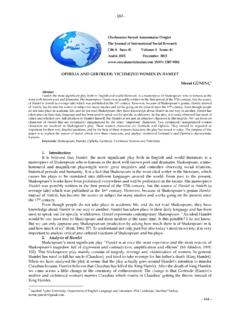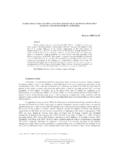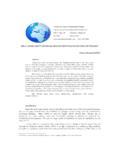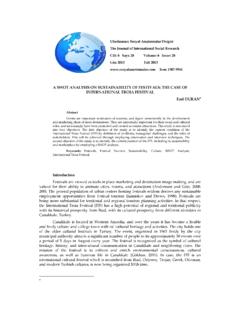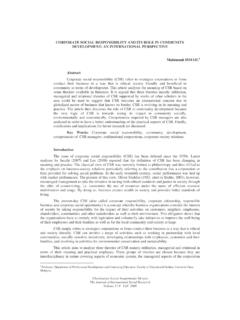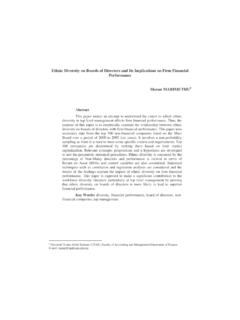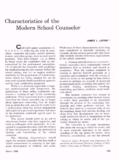Transcription of TEACHERS’ PERCEPTIONS ON CORPORAL …
1 Uluslararas Sosyal Ara t rmalar Dergisi The Journal of International Social Research Volume 2 / 8 Summer 2009 TEACHERS PERCEPTIONS ON CORPORAL punishment AS A METHOD OF DISCIPLINE IN ELEMENTARY SCHOOLS Song l K L MC Abstract Schools are meant to be the one of the safest places where students fulfill their educational practices. However many studies show that CORPORAL punishment is adopted worldwide in many schools. This article briefly examines CORPORAL punishment as a tool for providing discipline in education: tendency of the elementary school teachers and administrators to resort to CORPORAL punishment as a method of discipline, why they consider it as a primary discipline method and what they suggest to eliminate CORPORAL punishment . Based on the observations and interviews, the result of the research revealed that children are the victims of CORPORAL punishment at elementary schools.
2 Both the observations and the interviews proved that children s rights were abused. Results are discussed in theoretical and educational implication. Key Words: CORPORAL punishment , Discipline in Education, Teachers PERCEPTIONS The Convention on the Rights of the Child is the first legally binding international instrument to incorporate the full range of human rights civil, cultural, economic, political and social rights. The Convention sets out these rights in 54 articles and two optional protocols. It voices the basic human rights that children everywhere have: the right to survival; to develop to the fullest; to protection from harmful influences, abuse and exploitation; and to participate fully in family, cultural and social life. The four core principles of the Convention are non-discrimination; devotion to the best interests of the child; the right to life, survival and development; and respect for the views of the child.
3 Every right stated in the Convention is inherent to the human dignity and harmonious development of every child. The Convention protects children's rights by setting standards in health care; education; and legal, civil and social services (Unicef, 2009). On the other hand it is widely believed that discipline is required for students in order for them to be successful in education, especially during the compulsory education period. Rosen (1997) defines discipline as either a branch of knowledge-training that develops self-control, character, efficiency and strict control to enforce obedience- or as a treatment that controls and punishes as a system of rules. Eggleton (2001) defines it as a training which corrects molds or perfects the mental faculties, or moral characters, obedience to authority or rules, punishment to correct poor behaviors.
4 However, discipline does not necessarily have to involve CORPORAL punishment . CORPORAL punishment is usually related to school discipline with the term discipline itself which is problematic and has several ramifications for all actors in education (Slee 1995, Rosen 1997). Generally, school discipline is defined as school policies and actions taken by school personnel to prevent students from unwanted behaviors, primarily focusing on school conduct codes and security methods, suspension from school, CORPORAL punishment , and teachers methods of managing students actions in class (Cameron, 2006). The use of discipline is necessary to provide obedience to school rules. However the use of CORPORAL punishment to provide discipline might bring more harm than benefit. Gordon (1981) discusses that disciplining children is damaging their physical, emotional, and social well being.
5 He also points out the frequency of physical punishment in the public schools in Dallas where an average of 2000 incidents were reported per month of using CORPORAL punishment . Almost double that number was reported by the Houston School District. Gordon also mentions the research of Reardon and Reynolds (1979) which shows that from 60% to 89% of parents support the legal use of CORPORAL punishment on their own kids by the schools. The results of several studies (Scarr,1995; Flynn,1996; Ramsburg,1997) indicate that CORPORAL punishment or spanking is usually considered as a primary discipline method in most countries, Dr. Cukurova University, Turkey; Uppsala University, Sweden, Uluslararas Sosyal Ara t rmalar Dergisi The Journal of International Social Research Volume 2 / 8 Summer 2009 Teachers PERCEPTIONS on CORPORAL punishment as a Method of Discipline in Elementary Schools 243 including the USA.
6 Teachers and school administrators resort to CORPORAL punishment to correct poor behaviors. Agbenyega (2006) reports on the practice of CORPORAL punishment in two basic schools in the Greater Accra District in Ghana. The findings reveal that an overwhelming majority of the teachers [94 and 98 percent] use CORPORAL punishment to enforce school discipline. The results further indicate that the majority of the teachers in both school sites administer CORPORAL punishment to students who perform poorly in academic work. This implies that students with special learning problems who are not officially identified may be punished often for poor performance. Another surprising aspect of this result is that a large number of teachers from all the schools indicate their unwillingness to discontinue CORPORAL punishment in their schools.
7 Robinson et al (2005) question the effectiveness of CORPORAL punishment and underline the side effects of CORPORAL punishment such as running away, fear of teacher , feelings of helplessness, humiliation, aggression and destruction at home and at school, abuse and criminal activities. Gershoff (2002) also attributes CORPORAL punishment to increased aggression and lower levels of moral internalization and mental health and adds that adults who were corporally punished when children are more likely to be criminals, be violent with their sexual partner, and spank their own children. The Psychiatric News (as cited in Cryan, 1995) states that the psychological effects may be as harmful as the physical effects are. The reasons for student behavior problems should be examined in depth to solve this problem because many factors contribute to student behavior problems apart from the poor school and classroom management.
8 Jenson, Reavis and Rhode (1998) point to the importance of positive support with the difficult students because they usually have a history of punishment to which they have grown immune and they state that permanent behavior changes are maintained only by basic positive procedures. Similarly, Ramsburg (1997) notes that spanking, used as a primary discipline method, may have some potentially harmful effects such as increasing the chances of misbehavior. Punitive behavior management methods have been shown to be ineffective and in some cases harmful to students (Cameron, 2006). Verbal reprimands, persistent nagging of students about their behaviors may be effective in the short run but they do not work and students suffer from violence in the long run (Hyman and Perone, 1998), as it would cost more (Clark, 2004), cause aggression and violence (Straus, 1991).
9 Abebe and Hailemariam, (2007) note that the student behavior problems must be viewed as complex and multilevel and add that Society s number one goal should be to prevent the development of less than positive behaviors in children. Policy makers must give priority to prevention and proactive practices in the form of mandated child development and parenting classes for parents and enrichment and intervention programs for children (p, 16). Leach (2003) agrees with Abebe and Hailemariam stating that schooling is more than just teaching subject knowledge and employable skills. She suggests that subjects such as citizenship and democracy, life skills, guidance and counseling, and personal and social education should be included in the curriculum. If CORPORAL punishment may adversely affect a student's self-image and school achievement and may contribute to disruptive and violent student behavior, why, then, do the teachers, administrators and other school staff, in the name of discipline, often contribute to students misbehavior and aggression?
10 This study aims to seek answer to this question. The present study is a follow-up to an earlier investigation. The purpose of the earlier study was to determine the attitudes of teachers and administrators towards the students at schoolyards as far as children s rights were concerned. The investigation was conducted in 2004-2005 academic year, in 7 elementary schools at Seyhan and Yuregir districts in Adana, Turkey. The data obtained through observations and interviews were thematically categorized, analyzed within the framework of the principles of content analysis, evaluated, and discussed in terms of children s rights. The findings of the earlier study revealed that students with Low Socio Economic Level (L-SEL) were maltreated by teachers and administrators to handle discipline and establish the rules.
